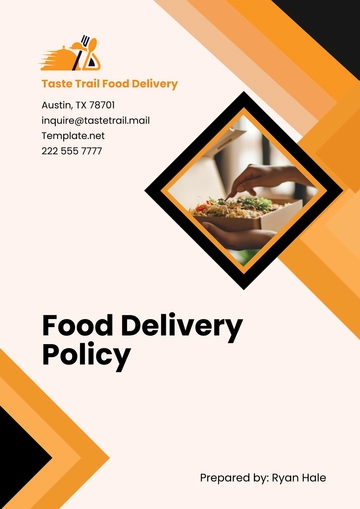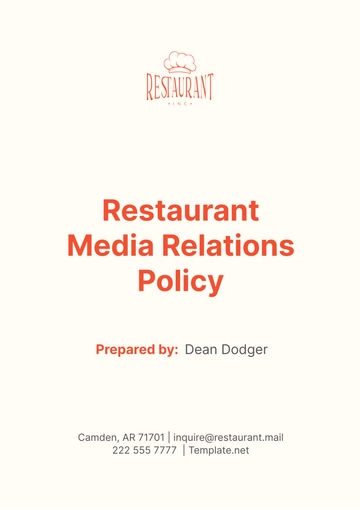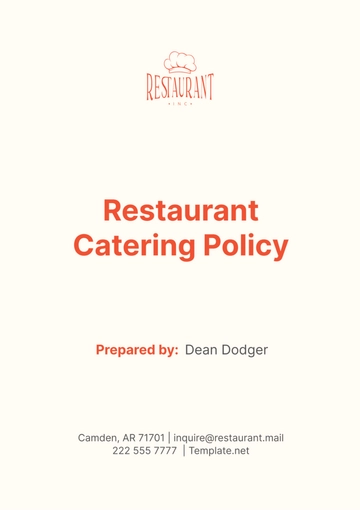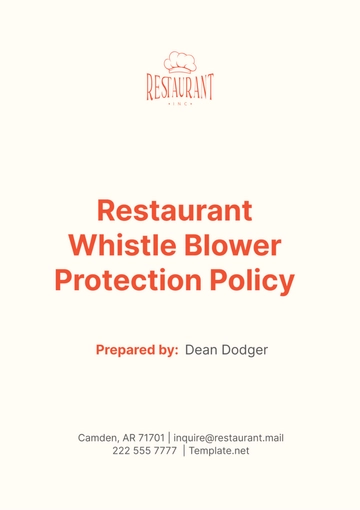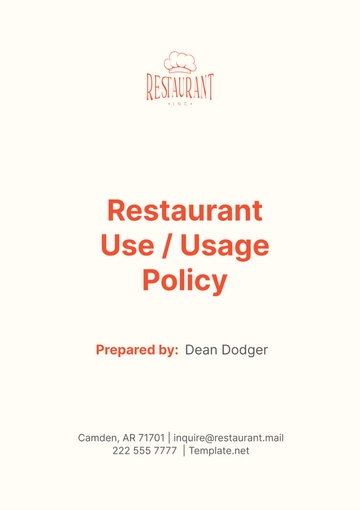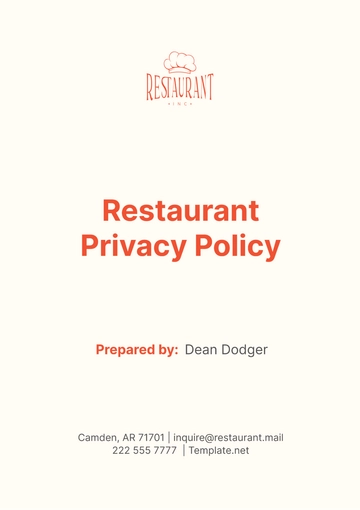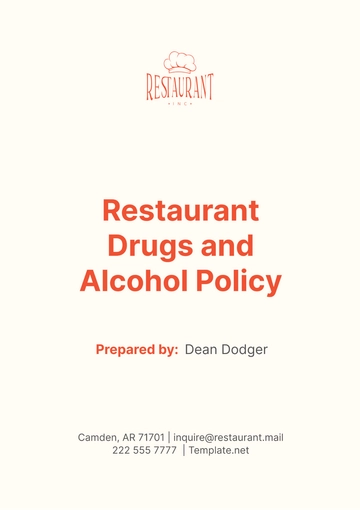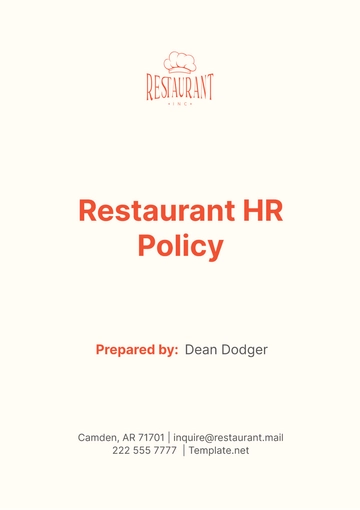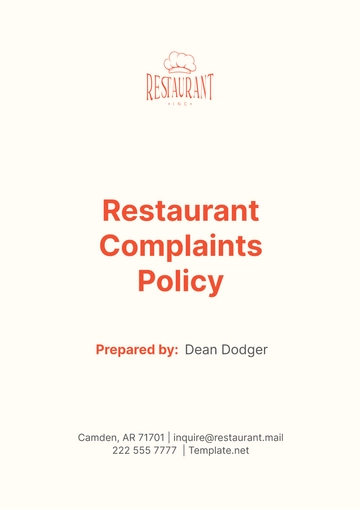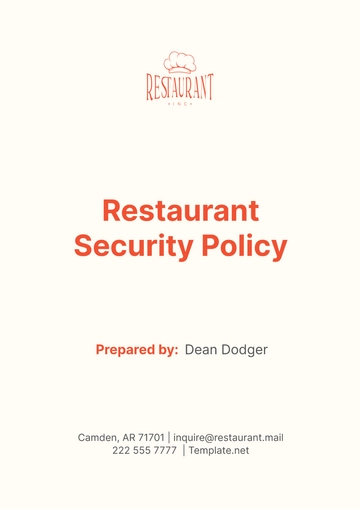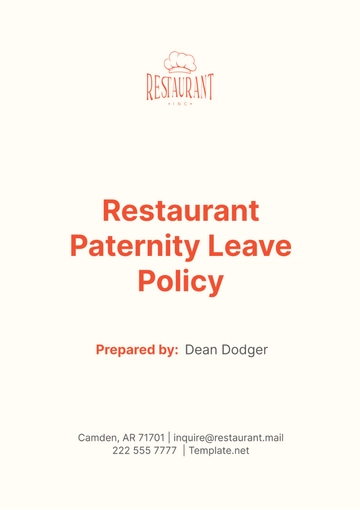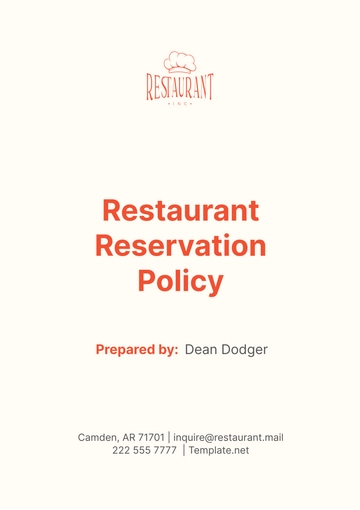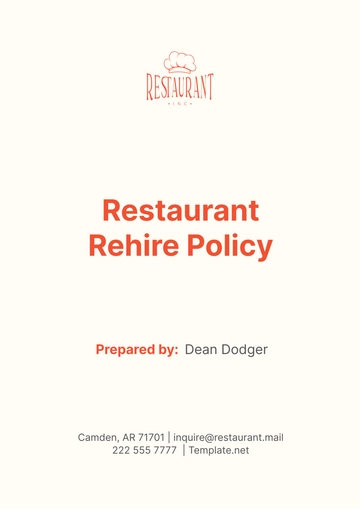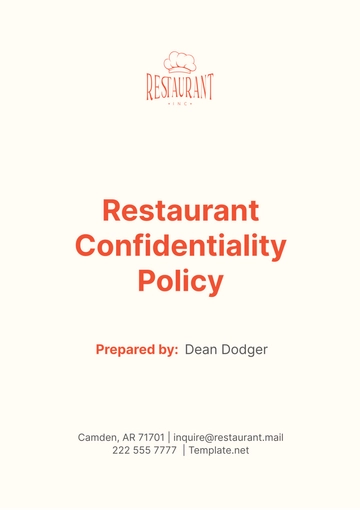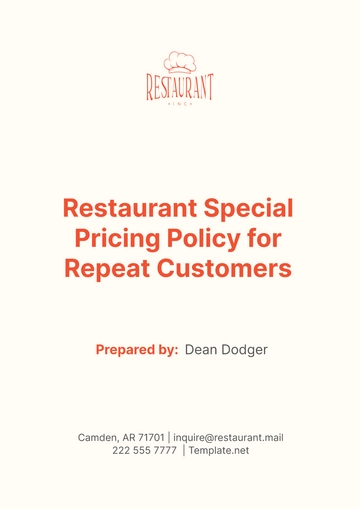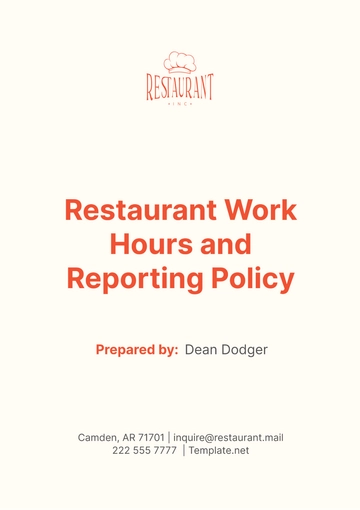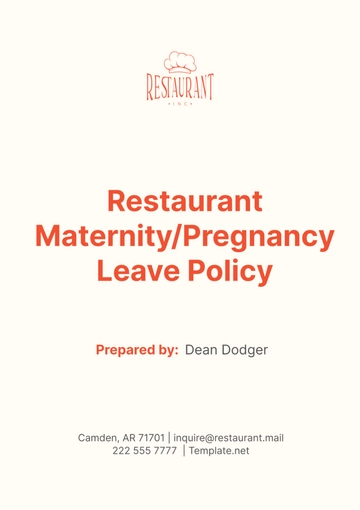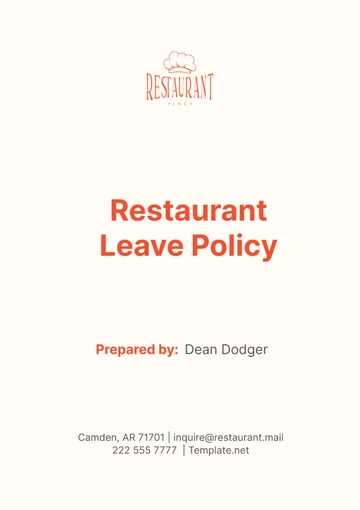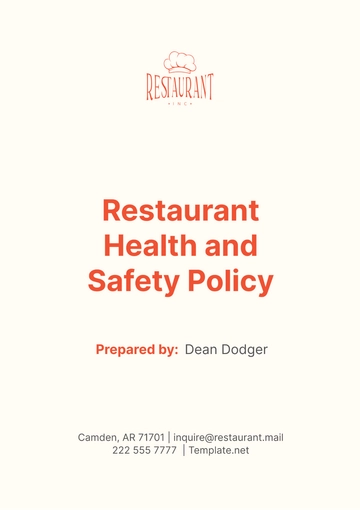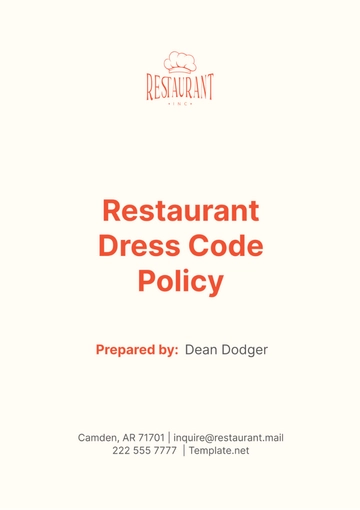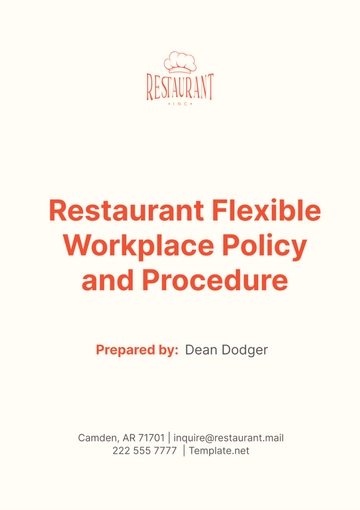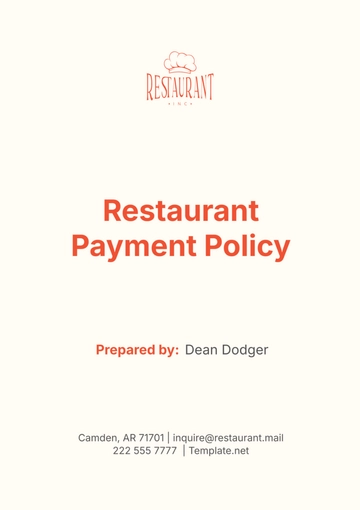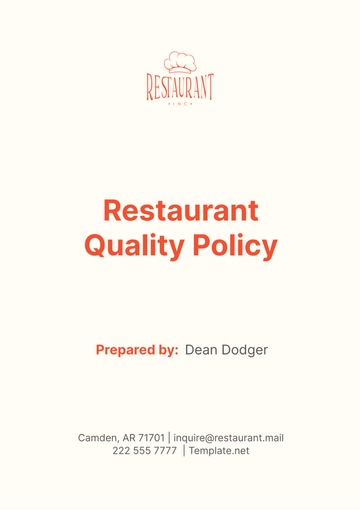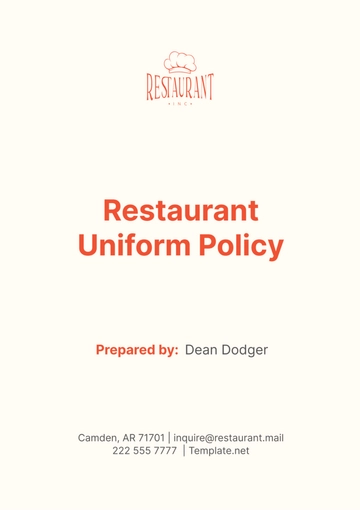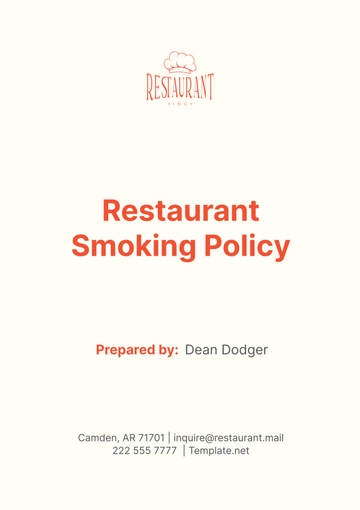Free Restaurant Social Media Policy
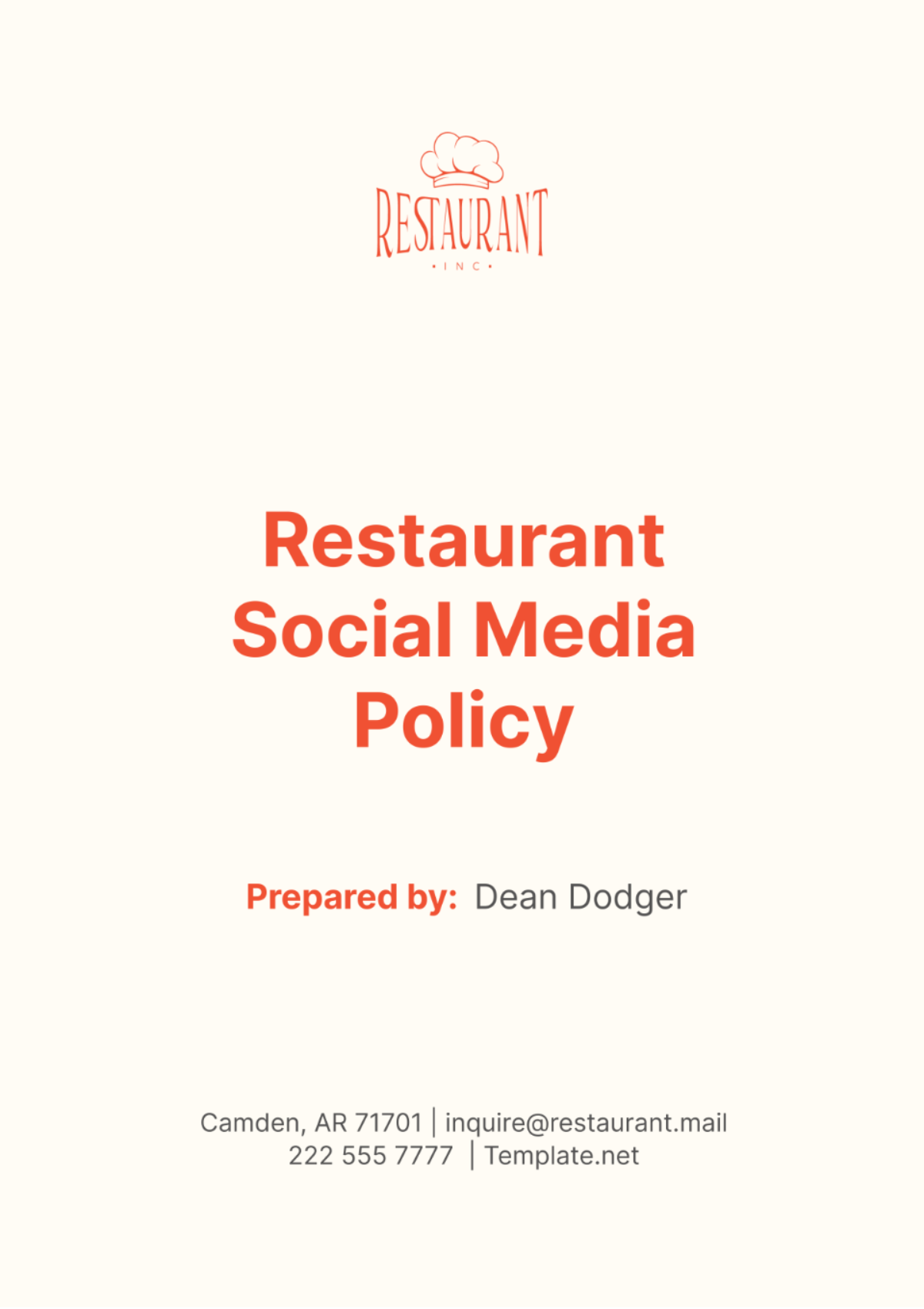
I. Introduction
A. Purpose of the Policy
The Social Media Policy for [Your Company Name] aims to provide clear guidelines on the appropriate use of social media by employees and representatives of the restaurant. This policy ensures that our brand is represented consistently and positively across all social media platforms, protects confidential information, and promotes respectful and professional interactions with customers and the public.
B. Scope and Applicability
This policy applies to all employees, contractors, and affiliates of [Your Company Name] who engage in social media activities on behalf of the restaurant. It covers all social media platforms, including but not limited to Facebook, Instagram, Twitter, LinkedIn, TikTok, and any other social networking sites or apps. This policy also applies to personal social media use when employees are identified as representatives of [Your Company Name].
II. Objectives
A. Enhance Brand Visibility
One of the primary objectives of our social media presence is to enhance the visibility of [Your Company Name]. By consistently posting high-quality content, engaging with followers, and utilizing effective marketing strategies, we aim to increase our reach and attract new customers.
B. Engage with Customers
Social media provides a valuable opportunity to interact with our customers in real-time. We strive to create a welcoming and engaging online community where customers feel valued and heard. Responding to comments, messages, and reviews promptly and professionally is a key aspect of this engagement.
C. Promote Specials and Events
Our social media channels play an indispensable role in the promotion of special discounts, upcoming events, and distinct seasonal menus. By consistently updating and informing our followers about the latest developments and offerings at [Your Company Name], we are able to effectively attract more visitors to our restaurant, thereby enhancing patronage and increasing our sales revenue.
D. Address Customer Feedback
Social media is a critical platform for receiving and addressing customer feedback. Whether the feedback is positive or negative, it provides us with insights into our customers' experiences and areas for improvement. Handling feedback constructively and courteously is essential for maintaining our reputation.
III. General Guidelines
A. Representing the Brand
Employees representing [Your Company Name] on social media must always convey a professional and positive image. Posts should reflect our brand values, mission, and vision. Personal opinions should not be presented as the views of the restaurant.
B. Tone and Voice
The tone of our communications on social media platforms should embody a friendly, approachable, and authentic manner. Our goal is to establish a welcoming online environment that reflects the warm and inviting atmosphere patrons experience when they visit our restaurant in person. It is important to refrain from the use of slang, technical jargon, or language that is overly informal, as such expressions might lead to misunderstandings.
C. Confidentiality
It is of utmost importance that confidential information pertaining to [Your Company Name], which encompasses business strategies, financial data, details about our employees, and proprietary recipes, should under no circumstances be shared or discussed on social media platforms. Safeguarding this sensitive information is crucial for our company’s integrity and success.
D. Respectful and Inclusive Communication
Every interaction that takes place on social media platforms must be conducted with respect and inclusivity at the forefront. Content that is discriminatory, offensive, or otherwise inappropriate is strictly prohibited and will not be allowed under any circumstances. Our commitment is strong towards nurturing an online community that values diversity and inclusivity, ensuring a welcoming environment for all participants.
IV. Social Media Platforms
A. Primary Platforms
We focus our social media efforts on the following primary platforms:
Facebook: Ideal for sharing updates, promotions, events, and engaging with a broad audience.
Instagram: Best for visually-driven content such as photos, videos, and stories showcasing our dishes, events, and behind-the-scenes moments.
Twitter: Useful for real-time updates, customer service interactions, and participating in relevant conversations.
B. Secondary Platforms
Secondary platforms include:
LinkedIn: Used for professional networking, recruiting, and sharing business-related news.
TikTok: Leveraged for creating engaging and creative short-form videos that can attract a younger demographic.
C. Platform-Specific Guidelines
Each social media platform has unique characteristics and best practices. Here are some platform-specific guidelines:
| |
| |
| |
| |
TikTok |
|
V. Content Creation and Posting
A. Content Approval Process
To ensure consistency and quality, all social media content must go through an approval process. Content creators should submit posts for review to the designated social media manager. The manager will check for alignment with brand guidelines, accuracy, and appropriateness before scheduling or publishing.
B. Frequency of Posts
Maintaining a consistent posting schedule is crucial for keeping our audience engaged. The recommended posting frequency is as follows:
Facebook: 3-5 times per week
Instagram: Daily posts and stories
Twitter: Multiple times per day
LinkedIn: 1-2 times per week
TikTok: 2-3 times per week
C. Types of Content
A diverse content mix keeps our social media channels vibrant and engaging. Here are some types of content we should regularly post:
Photos: High-quality images of our dishes, restaurant ambiance, and events.
Videos: Behind-the-scenes clips, cooking demonstrations, customer testimonials, and event highlights.
Stories: Daily updates, quick polls, customer interactions, and limited-time offers.
Reels/TikTok Videos: Short, engaging videos featuring recipes, food trends, and restaurant culture.
Articles: Blog posts about restaurant news, culinary tips, and industry trends.
Events: Announcements for upcoming events, special nights, and holiday celebrations.
D. Use of Hashtags and Tags
Effective use of hashtags and tags can significantly boost our content's reach. Here are some best practices:
Branded Hashtags: Use our official hashtag, e.g., #[YourCompanyName]Eats, to create a cohesive brand presence.
Popular Hashtags: Incorporate popular and relevant hashtags to increase visibility, such as #Foodie, #RestaurantLife, and #Delicious.
Geotags: Always include location tags to attract local customers.
User Tags: Tag customers and collaborators in posts to encourage sharing and engagement.
Sample Posting Schedule (Table)
Day | Platform | Content Type | Description |
|---|---|---|---|
Monday | Photo | Dish of the Week Feature | |
Tuesday | Event Announcement | Upcoming Wine Tasting Event | |
Wednesday | Real-Time Update | "Midweek Special: Half-Price Appetizers Tonight!" | |
Thursday | Behind-the-Scenes Story | Chef Preparing New Menu Items | |
Friday | TikTok | Short Video | Fun Friday: Staff Dance Challenge |
Saturday | Customer Testimonial | Highlight Positive Customer Reviews | |
Sunday | Blog Article | "The Evolution of Farm-to-Table Dining" |
VI. Customer Interaction
A. Responding to Comments and Messages
Effective customer interaction on social media is crucial for building and maintaining relationships with our patrons. At [Your Company Name], we aim to respond to comments and messages within 24 hours. Prompt responses demonstrate our commitment to customer service and help foster a sense of community. Here are guidelines for handling different types of interactions:
Positive Comments: | Thank customers for their kind words and encourage them to visit again. |
Example: | "Thank you for your wonderful feedback! We're glad you enjoyed your meal and look forward to welcoming you back soon." |
Neutral Comments: | Acknowledge the comment and provide relevant information or clarification. |
Example: | "Thank you for your input! Our new menu items will be available next month. Stay tuned for updates!" |
Negative Comments: | Address the issue with empathy, apologize if necessary, and offer to resolve the matter offline. |
Example: | "We're sorry to hear about your experience. Please DM us your contact information so we can make it right." |
B. Handling Negative Feedback
Negative feedback is an opportunity to demonstrate our commitment to customer satisfaction. Here are steps to handle negative feedback effectively:
Acknowledge the Issue: | Recognize the customer's concern without being defensive. |
Example: | "We're sorry to hear that your visit did not meet expectations." |
Apologize: | Offer a sincere apology for any inconvenience caused. |
Example: | "We apologize for any inconvenience you experienced." |
C. Encouraging Positive Reviews
Positive reviews are essential for our online reputation. Encourage satisfied customers to leave reviews by:
Directly Asking: | Politely request reviews from happy customers after a positive interaction. |
Example: | We're glad you enjoyed your meal! If you have a moment, please leave us a review on [platform]." |
Incentives: | Offer small incentives, such as discounts or special offers, for customers who leave reviews. |
Follow-Up Emails: | Send follow-up emails to customers thanking them for their visit and requesting a review. |
VII. Employee Guidelines
A. Personal vs. Professional Accounts
Employees should clearly distinguish between personal and professional social media accounts. Personal accounts should not be used to conduct business on behalf of [Your Company Name], and professional accounts should adhere to the following guidelines:
Professional Accounts: Should reflect the brand's values and maintain a professional tone at all times.
Personal Accounts: Should not share confidential information or post content that could damage the restaurant's reputation.
B. Employee Conduct on Social Media
Employees representing [Your Company Name] on social media must adhere to the highest standards of conduct. This includes:
Professionalism: Always maintain a professional tone, even when handling negative comments or complaints.
Respect: Treat all customers and colleagues with respect and courtesy.
Confidentiality: Do not share proprietary information, internal communications, or any other confidential content.
C. Sharing Restaurant Content
Employees are encouraged to share restaurant content on their personal social media accounts to help promote the brand. However, they must ensure that:
Content is Approved: Only share content that has been approved by the social media manager.
Appropriate Tags: Use appropriate hashtags and tag the restaurant's official account to ensure visibility.
Respect for Privacy: Do not share images or information about colleagues or customers without their consent.
VIII. Legal and Compliance Issues
A. Intellectual Property
All content created for [Your Company Name]'s social media accounts, including images, videos, and text, is the property of the restaurant. Employees must:
Respect Copyrights: Do not use copyrighted material without permission.
Credit Creators: Always give credit to original creators when sharing third-party content.
Obtain Permissions: Ensure that we have the necessary permissions for using any external content.
B. Privacy and Data Protection
We must protect the privacy of our customers and employees. Here are the guidelines:
Personal Information: Do not share the personal information of customers or employees without their explicit consent.
Data Security: Follow best practices for securing data, such as using strong passwords and enabling two-factor authentication.
Compliance: Adhere to data protection regulations, such as GDPR or CCPA, as applicable.
C. Adherence to Platform Policies
We must comply with the terms of service and policies of each social media platform. This includes:
Content Standards: Avoid posting prohibited content, such as hate speech, explicit material, or false information.
Advertising Guidelines: Follow platform-specific guidelines for advertising and promotions.
Community Guidelines: Respect the community guidelines to maintain a positive and compliant presence.
IX. Monitoring and Reporting
A. Tracking Social Media Performance
Tracking and analyzing our social media performance is crucial for understanding the effectiveness of our strategies and making informed decisions. The table below outlines the key performance indicators (KPIs) we will track and their descriptions:
KPI | Description | Frequency | Tools Used |
|---|---|---|---|
Engagement Rate | Measures the level of interaction with our content (likes, comments, shares, mentions). | Weekly | Facebook Insights, Instagram Insights, Twitter Analytics |
Reach and Impressions | Number of people who see our content and the number of times it is displayed. | Weekly | Facebook Insights, Instagram Insights, Twitter Analytics |
Follower Growth | Tracks the increase in the number of followers on our social media platforms. | Monthly | Platform Analytics |
Click-Through Rate | Measures how often people click on links in our posts. | Monthly | Google Analytics, Bitly |
B. Reporting Issues and Concerns
It is essential to have a structured approach to reporting any issues or concerns that arise on social media. The table below outlines the types of issues, actions to be taken, and responsible personnel:
Issue Type | Description | Action to Be Taken | Responsible Personnel |
|---|---|---|---|
Negative Comments/Reviews | Persistent negative feedback affecting reputation. | Escalate to social media manager for resolution. | Social Media Manager |
Suspicious Activity | Hacked accounts, inappropriate messages, etc. | Report immediately to IT department. | Social Media Team |
Technical Issues | Problems with posting, accessing accounts, etc. | Contact platform support and report issue to IT. | Social Media Team |
C. Regular Review of the Policy
To ensure the Social Media Policy remains relevant and effective, we will conduct regular reviews. The table below outlines the review schedule and responsible parties:
Review Frequency | Description | Responsible Parties |
|---|---|---|
Annual Review | Comprehensive review of the entire policy. | Social Media Manager, Senior Management |
Feedback Review | Incorporate feedback from employees/customers. | Social Media Manager |
Trend Review | Update policy based on industry trends. | Social Media Manager, Marketing Team |
X. Training and Support
A. Social Media Training for Staff
Providing comprehensive social media training ensures that our staff is well-equipped to manage our online presence effectively. The table below outlines the training sessions and their content:
Training Session | Content | Frequency | Responsible Parties |
|---|---|---|---|
Policy Overview | Detailed explanation of the social media policy. | Annually | Social Media Manager |
Platform-Specific Training | Best practices for using each social media platform. | Quarterly | Social Media Team |
Content Creation | Guidelines for creating engaging and compliant content. | Bi-Annually | Marketing Team |
Crisis Management | Strategies for handling negative feedback and social media crises. | Annually | PR and Social Media Manager |
B. Access to Resources and Tools
To manage our social media presence effectively, staff should have access to the right resources and tools. The table below lists the essential tools and their purposes:
Tool | Purpose | Access Provided To |
|---|---|---|
Content Calendars | Plan and schedule social media posts in advance. | Social Media Team |
Design Tools | Create high-quality visuals for posts. | Marketing Team, Social Media Team |
Analytics Tools | Track and analyze social media performance. | Social Media Team, Management |
C. Continuous Learning and Development
Encouraging continuous learning ensures that our team stays updated on the latest social media trends and best practices. The table below outlines the continuous learning opportunities:
Learning Opportunity | Description | Frequency | Responsible Parties |
|---|---|---|---|
Workshops | Participate in social media workshops and training. | As Available | Social Media Team, Marketing Team |
Trend Monitoring | Stay updated on the latest social media trends. | Ongoing | Social Media Team |
Knowledge Sharing | Regularly share insights and best practices within the team. | Monthly | Social Media Manager |
By implementing these comprehensive guidelines for monitoring, reporting, training, and support, [Your Company Name] ensures a robust and effective social media strategy that enhances our online presence and engages our community positively.
XI. Consequences of Policy Violation
Disciplinary Actions
Violations of the Social Media Policy can have serious consequences. Depending on the severity of the violation, disciplinary actions may include:
Warnings: Issuing a formal warning for minor infractions.
Suspension: Temporary suspension from social media duties for repeated violations.
Termination: Termination of employment for severe or repeated policy breaches.
Examples of Violations
To provide clarity, here are some examples of policy violations:
Sharing Confidential Information: Posting proprietary recipes or business strategies online.
Inappropriate Conduct: Using offensive language or engaging in discriminatory behavior on social media.
Misrepresentation: Presenting personal opinions as the official stance of [Your Company Name].
XII. Policy Review and Updates
A. Regular Review Schedule
The Social Media Policy should be reviewed annually to ensure it stays up-to-date with current practices and regulations. The review process involves:
Policy Assessment: Evaluate the effectiveness of the current policy.
Stakeholder Feedback: Gather feedback from employees and management.
Industry Trends: Incorporate changes based on new social media trends and platform updates.
B. Process for Updating the Policy
Updating the policy involves several steps to ensure thoroughness and compliance:
Draft Revisions: Prepare a draft of the updated policy, incorporating necessary changes.
Review by Legal Team: Ensure the policy complies with legal and regulatory requirements.
Management Approval: Obtain approval from senior management.
Employee Training: Communicate the updated policy to all employees and provide training on any new guidelines.
Implementation: Put the updated policy into effect and monitor its adherence.
XIII. Conclusion
A. Summary of Key Points
The Social Media Policy for [Your Company Name] provides comprehensive guidelines to ensure a positive and professional online presence. Key points include:
Brand Representation: Maintaining a consistent and positive brand image.
Customer Interaction: Engaging with customers respectfully and promptly.
Content Creation: Following approval processes and best practices for content.
Employee Conduct: Ensuring professional behavior on social media.
Legal Compliance: Adhering to intellectual property, privacy, and platform policies.
Monitoring and Reporting: Regularly tracking performance and addressing issues.
Training and Support: Providing resources and training for effective social media management.
B. Encouragement for Compliance
Adhering to this policy is essential for protecting and enhancing the reputation of [Your Company Name]. We encourage all employees to familiarize themselves with the guidelines and contribute positively to our social media presence. Together, we can create a vibrant and engaging online community that reflects the values and quality of [Your Company Name].
- 100% Customizable, free editor
- Access 1 Million+ Templates, photo’s & graphics
- Download or share as a template
- Click and replace photos, graphics, text, backgrounds
- Resize, crop, AI write & more
- Access advanced editor
Manage your online presence with Template.net's Restaurant Social Media Policy Template. This customizable and editable template, accessible through the Ai Editor Tool, helps you establish clear guidelines for social media use. Personalize it to align with your restaurant’s brand and ensure consistent messaging. Develop a comprehensive policy to guide your team in maintaining a professional and engaging social media presence.
You may also like
- HR Policy
- Restaurant Policy
- Company Policy
- Accounting Policies and Procedures
- Website Policy
- Privacy Policy
- Safety Policy
- School Policy
- IT and Software Policy
- Law Firm Policy
- Construction Policy
- Interior Design Policy
- Travel Agency Policy
- Education Academic Policy
- Security Policy
- Real Estate Policy
- Expense Policy
- Software Policy
